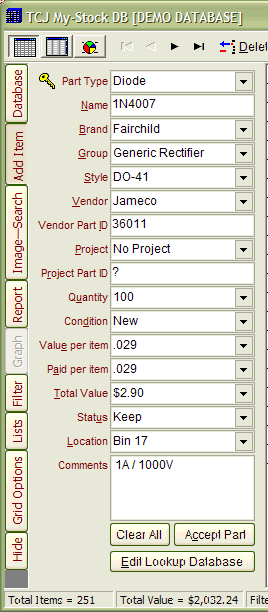| John Broskie's Guide to Tube Circuit Analysis & Design |
 Which Tube Should I Use? Which Tube Should I Use?
|
||||
02 March 2005 Cathode resistors revisted Since mentioning the results from the European Triode Festival wherein an unbypassed cathode resistor beat out alternate cathode-bias devices, such as an LED or a battery, a few readers have asked how to remove all cathode bypass capacitors. From one extreme to another… Yes, indeed, an unbypassed cathode resistor will lower a grounded-cathode amplifier's distortion, within reason. That last clause— within reason —is crucial, yet usually omitted. Instead, many slam into an extreme position that all bypassed cathode resistors are bad and, thus, the larger the unbypassed resistor, the better. Well, isn’t it? Imagine a cathode resistor so large in value that it approximates a constant-current source: 100 Meg, for example. What would be the result? Zero distortion? Well, it’s hard to say as a grounded-cathode amplifier's gain drops to zero when the cathode is loaded by a constant-current source. (If the plate resistor sees a constant current flow, it cannot experience any signal-induced variations in current.) So does zero gain equal zero distortion… or infinite distortion? Here’s the punch line: too much cathode resistance can be just as bad as too little. So is there an optimal value and, if so, how could it be found? The answer was provided almost fifty years ago by George Fletcher Cooper, in Audio magazine (for the younger readers, Audio was once a great magazine, nothing like what it devolved into in its last years) . I have scanned, OCRed, proofread, retyped the equations in MS Word equation editor, and re-illustrated Cooper’s article. (Why not just scan and render into a PDF, as it would have taken a small fraction of the time? I don’t like image-laden PDFs, as they cannot be searched, edited, or copied because there’s no text, only bitmap. Think about it: in our grand information age, 90% of the possible information is invisible to Google. Most books have not been converted into text files; scanned-but-not-OCRed books are the dark matter in the informational universe. We know they are there, but Google cannot see what is in them. Besides, I owe Copper more than a quick scan job.) Cooper’s article was a godsend to me back in the early 1980’s. First of all, I love the way Cooper wrote the article, with humor and grace. (My recommendation is to read anything you can find written by him.) His article deals with a complex topic and is math laden, which means that it could have easily been rendered unreadable by a lesser writer, but Cooper is entirely with us on this journey, helping us grasp the hard to understand, while providing good company along the way. Second, he provides powerful insights into what is going on in a grounded-cathode amplifier. He explains in detail what an unbypassed cathode contributes to a signal’s amplification and how to exploit it fully. Do not let the math scare you away, it’s not as bad as it looks. If nothing else, be sure to read the last three paragraphs. Just click on the title below to download the PDF. Which Tube Shall I Use ?
//JRB |
Only $12.95 Download or CD ROM www.glass-ware.com |
|||
| www.tubecad.com Copyright © 1999-2005 GlassWare All Rights Reserved |
















